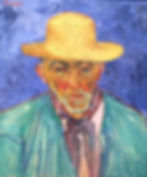A Face-to-Face Encounter
- Christopher Graves
- Jul 15, 2021
- 4 min read
Updated: Aug 19, 2021

During the summer of 1987 I was a young first year college art student, passionately obsessed with learning everything I could about my newly chosen profession. While working to improve my own artistic skills, I was a bit of an art history sponge - I couldn’t get enough information about art, and particularly painting and drawing. I poured over the latest art news, and absorbed my art history courses and those thick textbooks like they were light snacks. I loved it all.
But back then the only place you could see the works of the masters and learn from them was mostly from dingy books or older posters, and most were older prints with poor reproductions. From my perspective Michelangelo painted the Sistine Chapel in browns and greys, until years later the cleaned version came out and showed the power of Michelangelo's color that burst off the walls. That was a very common experience for me, seeing works in a dingy book, then years later being exposed to the real thing.
I first discovered Van Gogh from Kirk Douglas in the movie "Lust for Life", blown away by the passion, energy and color that burst out of his canvas. I was emotionally and psychologically drawn to him and his work, as well as Degas, Matisse, Picasso etc. Determined to actually see work from some of my new artistic heroes, my newly married wife and I saved for a road trip to Los Angeles, with the primary purpose of going to the Norton Simon and the LACMA. I felt compelled to go - I HAD to go. Little did I know what an impact it would make on me.
I remember pulling into the parking lot of the Norton Simon in Pasadena, CA. I was really nervous, like I had to give a talk or something. My wife had to call me back as I took off from the car without her, not realizing what I had done. Out front of the museum is Rodin’s Burgher’s of Calais, a powerful set of sculptures that tell such a compelling story. We walked around it a few times marveling at it’s scale and raw emotion. But as we walked inside I will never forget the experience of seeing Van Gogh’s Portrait of a Peasant (Patience Escalier). It caught my eye first thing, even though it was about 75 feet away, and like a magnet it drew me in slowly, step by step, ignoring everything else. I didn’t see or hear anything for 10 minutes as I made my way toward the painting, transfixed and glued to it. The shimmering blue background made the golden yellow hat burst out from the wall to me - but then I saw his face with the aggressive ochres and reds, contrasted with the teal beard that made me stand in one place for 20 minutes. My patient wife whispered she was moving on, which I barely heard, as I continued to explore the painting inch by inch, thick brush stroke at a time.
I didn’t know paint could do that. My first year of art school had resulted in awkward and clumsy work, just barely knowing how to hold a brush, let alone paint anything. I had no idea the almost spiritual connection that paint can envelope one in. I had no idea you could create an essence of a man or woman that still connects over a hundreds of years later. I think I had seen that particular piece in a book somewhere, but it was a dingy reproduction that I just glossed over. Little did I know what would happen when I stood in front of it. For me it was the first time I had a conversation of sorts with Vincent, asking him what was he thinking as he painted this, why did this man compel him to paint in that way? To me what happened that day still resonates today just as powerful as it happened over 30 years ago.

Experiences such as this can only happen in person - face to face, so to speak, with the art and the artist. They are aesthetic conversations that resonate, that compel and inspire. Sometimes these experiences compel me to draw, sometimes just to think, but something always happens. So it is with this Art in Europe tours that I will be leading, I am convinced of the profound experience that seeing face to face the masters of art can have, inspiring and creating an aesthetic education that cannot happen on a computer or your phone. This is one of the major reasons I continue to lead tours to some of the worlds great cities and museums, to see that growth and the good it can have in people's lives.
The Van Gogh Museum in Amsterdam always provides for me this kind of experience, and no matter how many times I go I seem to be transported to 1987 as a young art student trying to find his way as an artist. In that museum you get a full education of who Vincent was from his extensive writings, drawings and paintings. But by the time you come to one of his last pieces, Wheatfield with Crows, and ponder his short life and the potential that was cut short, I promise that you will be moved. I still am.
Here's a list of just some of the masters you will see on the Art in Europe Trip. There are so many more, but these are just a few of my favorites that are a delight to discover and rediscover:
Dutch Masters
Rembrandt
Vermeer
Haals
Bruegel
Renaissance Masters
DaVinci
Michelangelo
Rubens
Titian
Botticelli
Impressionists
Van Gogh
Renoir
Monet
Degas
Modernists
Picasso
Matisse
Turner
Rodin
Kandinsky
Malevich
Mondrian
And many, many more
